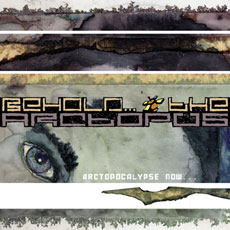
Metal music begins as an intensification of Rock: If rock music is music marked by a great emphasis on rhytmn, Metal music intensified that emphasis, making rhytmn not only the backbone, but also the flesh and blood of the music. Emphasising rhytmn does not necessarily mean playing fast: Black Sabbath’s Iron Man (a metal song, even if one of the first) is not a fast song, but it has a really intense rhytmn. What I’m talking about here is, err… “headbangability”. Headbanging is a result of your body responding to a very intensified rhytmn. If you can’t headbang to an average metal song, it’s probably no good.
However, in order to inovate, musicians must go where other musicians have not been yet. In metal’s case, this means playing faster. And than faster, and faster, and faster… Anyone can see that, if things remained as they were, extreme forms of metal would eventually reach the human limit of speed, and after that metal would end.
Luckily, things turned out a lot better for the style: it received the influences of many other styles of rock music, which helped it develop without the need to always point to the extreme. Perhaps the most important influence metal received came from progressive rock (and jazz, although to a smaller extent, not as important, and with results many times similar to progressive rock inspired metal groups). As early as the second half of the 80’s, metal bands appeared that mixed the intense rhytmn of metal with other elements, such as extremely technical playing, odd time signatures and longer and more complexly structured songs. Bands such as Watchtower, Atheist and Cynic are important in this period. Other more obvious bands could be shown, such as Queensrÿche and Dream Theater, but they are not as important to the analysis being made here.
Thing is, despite these influences, metal did not lose its tendency to the extreme: rhytmns began getting faster, more and more complex, and almost inhumanly technical. Bands like Nile, Necrophagist and Behemoth are bands that I feel represent the most extreme exaggeration (not in a bad way, far from it) of metal’s fundamental aspects. So fast, heavy, complex and agressive that it’s hard to believe such music is made by humans like ourselves (by this I mean: with the same number of arms and fingers).
Perhaps as a reaction to this, metal developed other styles, such as sludge, doom and drone metal, that mantain the emphasis on rhytmn, but turn it upside-down: Now, rhytmn is also the main aspect of the music, but not because it’s so fast: on the contrary, the instensity remains, but the speed is absurdly slow. This is what makes possible the appearence (in the late 90’s or early 2000’s, I can’t exactly remember right now) of Boris’ Absolutego, a one hour long piece of ridiculously slow and heavy metal music. I’ve no real insterest in going deeper into this side of metal (the “slow” side). All I’ve said so far is to prove, by all means possible, that metal is becoming EXTREME.
And if I chose to talk about Behold… the Arctopus, it is because I believe that, so far, they represent the furthest any band has ever gone down the path of extremely fast, instense, complex and technical metal music, which is saying a fucking lot. They may not be faster than Nile, but I would call them more complex. No band, actually, has songs more complex that theirs, I affirm, and if you disagree, I would love to be proven wrong, even if in this case I don’t think it’s possible. The number of melodic ideas conteined on a song like Exospacial Psionic Aura is superior to the number of such ideas on many albums by a band like, say, AC/DC (obviously not offending AC/DC, their music is simply different). These ideas, however, are 90% of the time extremely complex and technical, and rarely appear twice the same way. The band has a classical music influence that is vital to the understanding of their work. Melodies are developed and rearranged rather than repeated, musical ideas are explored to their full extent rather than remaining the same throught a song. The band members have named Arnold Schoenberg (remember him from a few posts ago???), Luciano Berio and Bela Bartok as influences, but I feel that what appears as most original in the band’s music is the influence of classical music, in a general way, not restricted to specific composers in the compositional method. Of course, with all this, their music makes for a very very difficult listening experience, but it has practically infinite depth and the consequences of such music will, hopefully, be felt in metal for a long time. What I mean is: in the extreme metal aesthetic, Behold… the Arctopus is the greatest point of reference. No one, in the style, has gone further.

The band begins with Colin Marston, a warr-guitarist (pictured right here on the left, with his disgustingly beautiful warr guitar), and Mike Lerner, a guitarist, composing extremely complex songs. Due to the nature of their music, they had a hard time finding a drummer who could play with them. Thus, they released what I believe was a download only ep, containing 2 songs named “we need a drummer” and “we really need a drummer”. They used a drum machine to record them, which must not have been much of a problem since their music is thouroughly written down in sheet form before being played, so they new how the drums should sound. Drummer Charlie Zeleny eventually heard them and joined. The 2 songs on the ep were then rehearsed and re-recorded, now being named “Alcoholocaust” and “You Will Be Reincarnated As An Imperial Attack Space Turtle”, respectively. The ep was then released in CD form, named Arctopocalypse Now… Warma ggedon Later and did gain some attention on the metal and prog (short for progressive metal and rock) underground. The second song, more specificaly, an 8 minute tour de force of enourmous complexity, dropped many jaws.
ggedon Later and did gain some attention on the metal and prog (short for progressive metal and rock) underground. The second song, more specificaly, an 8 minute tour de force of enourmous complexity, dropped many jaws.
Another ep followed, this one much more mature and well structured, named Nano-Nucleonic Cyborg Summoning. Containing 3 songs, this ep consolidated the band as the most complex band in the underground metal community. All 3 songs are extremely well composed pieces of music that, in my opinion, should be considered classical music despite the obvious heaviness. The depth and complexity of the compositions calls for an analysis in a classical music context, which I do not feel able to do. Nonetheless, any heavy metal fan who likes it hard and mean will have a fucking ball. The complexity of  the music serves to intensify it’s already quite agressive edge, as in all good complex music, and it’s agressiveness makes the complexity sound all the more, uh… complex. The first song, “Exospacial Psionic Aura”, begins with an extremely intense blastbeat (first time listeners be warned) altering measures of 5/4 and 6/4. the song then moves on the a new section in 11/8 before returning to the blastbeat melody, but now in a differente time signature. Eventually, the song’s central melodic idea appears, a five-note call from the guitar which the band answers and that never appears twice the same way. Weird as this may seem, this melodysticks to your head. You remember it, but since it is always different, you end up inventing part of it yourself, which adds an incredible touch of subjectivity and depth to the song. Further describing the song is near impossible, because it takes so many twists and turns that even after some 50 listens one cannot follow it all the way. It ends on a grandiose chord and gives way to "Estrogen/Pathogen Exchange Program", the second song, this one composed with Arnold Schoenberg’s 12 tone technique (remember???). Anyone who’s ever heard 12 tone music knows what to expect. It starts out very quiet, but about 2 minutes in the band kicks in and the usual compexity returns. One more point worth noting is on the 3rd song, “Sensory Amusia”: a calm, melodic and quite pretty middle section. Warr and guitar play a melody of each other in some very weird time signature, with the drums only keeping time lightly. Their full lenght album’s second song, “Canada”, will feature a similar section, but even better.
the music serves to intensify it’s already quite agressive edge, as in all good complex music, and it’s agressiveness makes the complexity sound all the more, uh… complex. The first song, “Exospacial Psionic Aura”, begins with an extremely intense blastbeat (first time listeners be warned) altering measures of 5/4 and 6/4. the song then moves on the a new section in 11/8 before returning to the blastbeat melody, but now in a differente time signature. Eventually, the song’s central melodic idea appears, a five-note call from the guitar which the band answers and that never appears twice the same way. Weird as this may seem, this melodysticks to your head. You remember it, but since it is always different, you end up inventing part of it yourself, which adds an incredible touch of subjectivity and depth to the song. Further describing the song is near impossible, because it takes so many twists and turns that even after some 50 listens one cannot follow it all the way. It ends on a grandiose chord and gives way to "Estrogen/Pathogen Exchange Program", the second song, this one composed with Arnold Schoenberg’s 12 tone technique (remember???). Anyone who’s ever heard 12 tone music knows what to expect. It starts out very quiet, but about 2 minutes in the band kicks in and the usual compexity returns. One more point worth noting is on the 3rd song, “Sensory Amusia”: a calm, melodic and quite pretty middle section. Warr and guitar play a melody of each other in some very weird time signature, with the drums only keeping time lightly. Their full lenght album’s second song, “Canada”, will feature a similar section, but even better.
Shit, this post turned out absurdly long. I’l leave the 2nd part for later. Do check the comments if you feel curious to hear the most absurd music in the world, and I mean this in an infinitely good way.


.jpg)





















